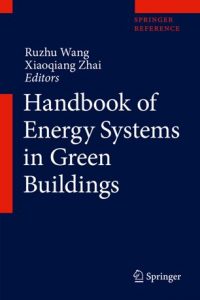Handbook of Energy Systems in Green Buildings
Handbook of Energy Systems in Green Buildings
Handbook of Energy Systems in Green Buildings provides a comprehensive summary on the energy systems used in green buildings, with a particular focus on solar energy – the most common renewable energy source applied in this field. With the growing concern about environmental protections, the concepts of green building have been widely promoted and implemented in nowadays building designs and constructions. Among all, sustainable energy systems, including energy harvesting, conversion, and storage, is one of most important design factors in green buildings. Unlike traditional energy systems which highly rely on fossil fuel, green buildings utilize renewable energy source or high efficient energy systems, or both, to provide environmental friendly, low carbon waste energy. The most updated concepts, designs, technologies developed and implemented in heat pumps, cooling systems, power systems, and energy storage will be discussed here in details.
You can also Read Kitchen Exhaust Ventilation
Handbook of Energy Systems in Green Buildings content
- Introduction to Green Building Concepts
- Challenges in the Modeling and Simulation of Green Buildings
- Definitions, Targets, and Key Performance Indicators for New and Renovated Zero Emission Buildings
- Bioclimatic Design of Green Buildings
![Handbook of Energy Systems in Green Buildings]()
- Solar Energy Systems
- Solar Collectors and Solar Hot Water Systems
- the Solar Water Heating System
- Efficient Heat Pump Energy Systems
- Combined Cooling, Heating, and Power (CCHP) Systems
- Efficient Heating and Cooling Technologies
- Energy Storage
- Passive Building Design
- Integrated Energy Systems in Green Buildings
- Cases of Energy Systems in Green Buildings
This handbook subdivided into 7-9 main sections to provide an in-depth discussion from foundation principles to practical techniques. In addition, different cases about green energy systems implemented in global will be discussed. The book structured easy-to-read, to make it more accessible to graduate students and professionals in diverse scientific and engineering communities, including applied physics, civil engineering, electrical engineering, mechanical engineering, material engineering, and chemical engineering.
Green building is the practice of creating structures and using processes that are responsible and resource-efficient throughout a building’s life cycle from siting to design, construction, operation, maintenance, and renovation.


Comments are closed.